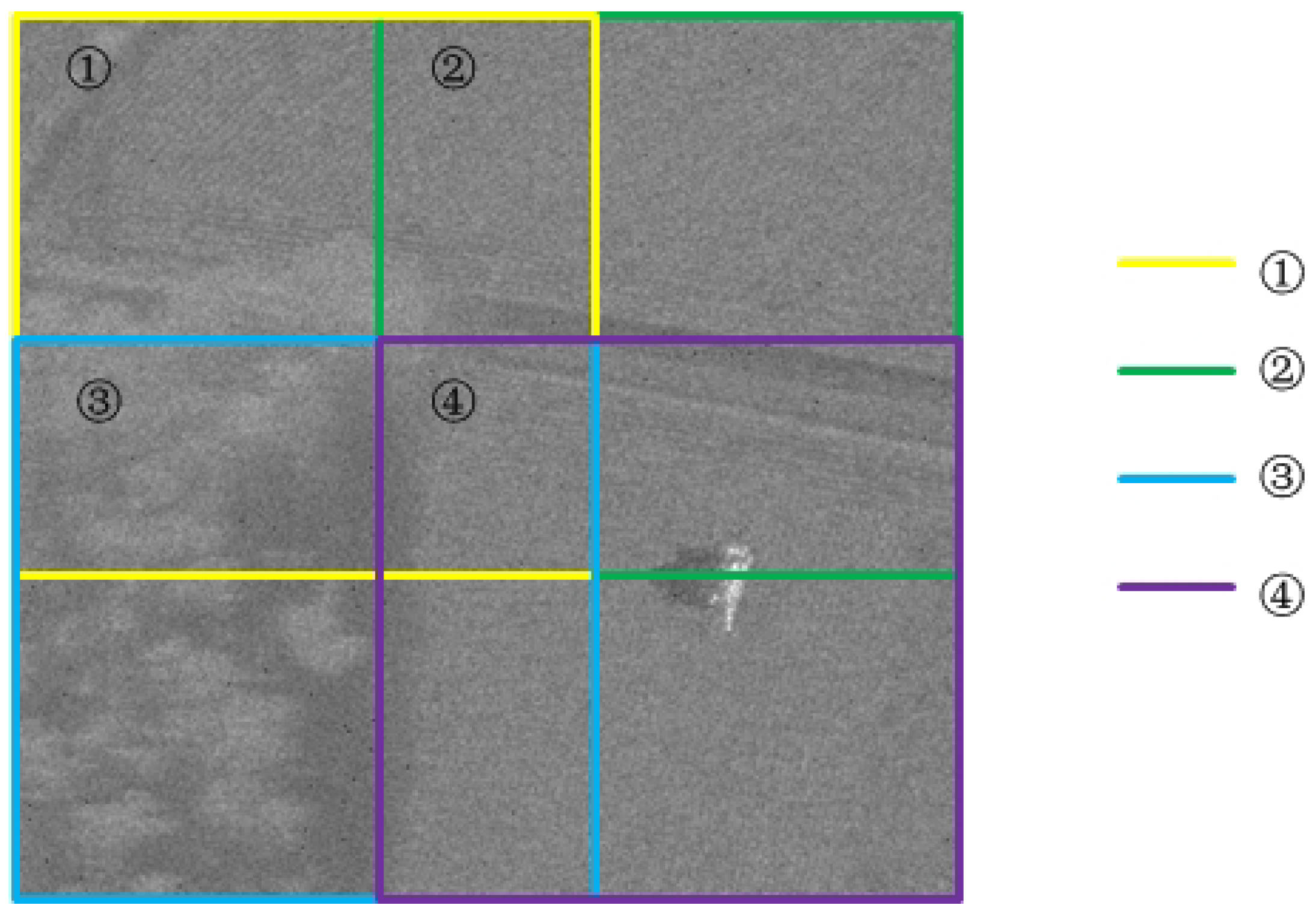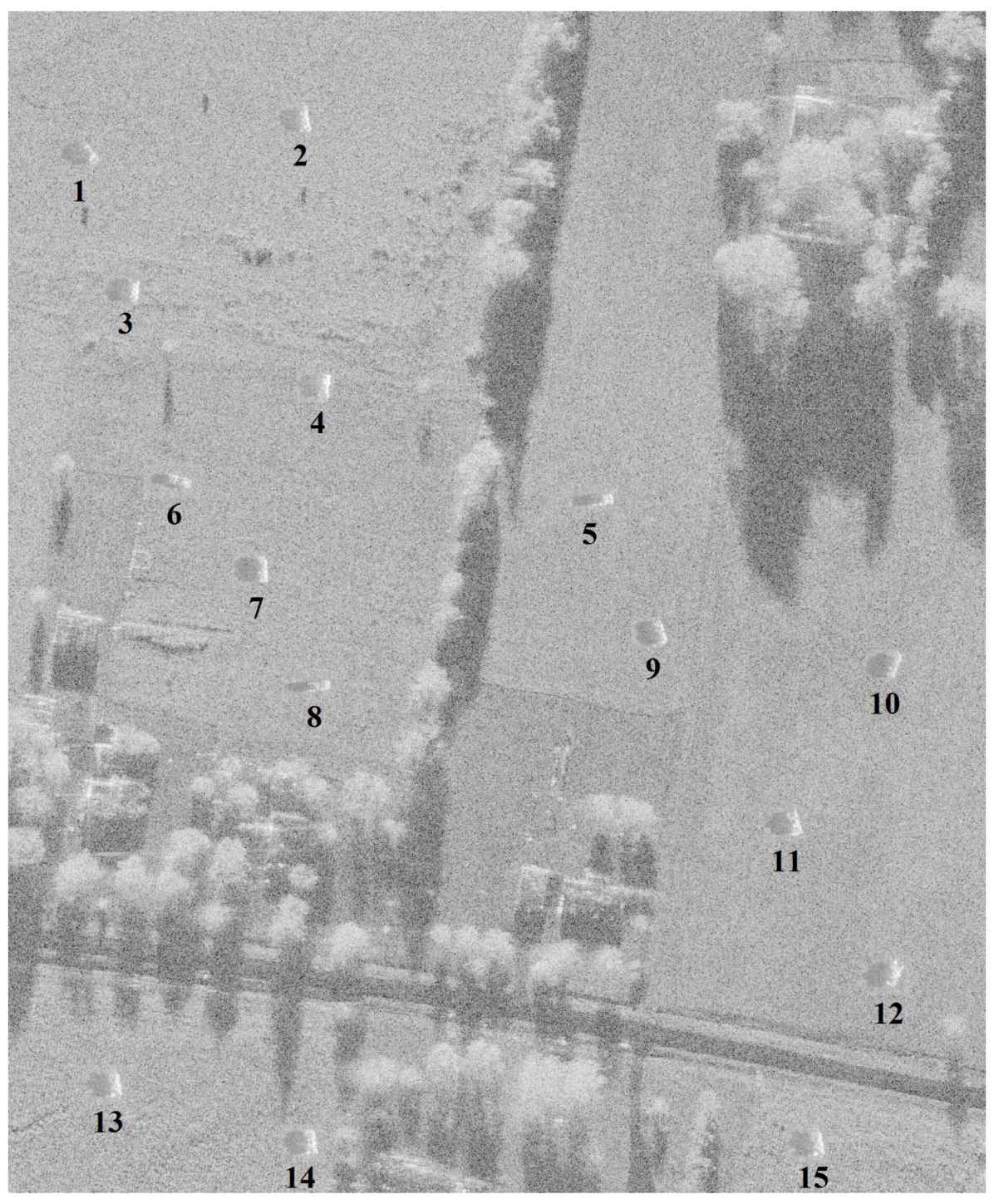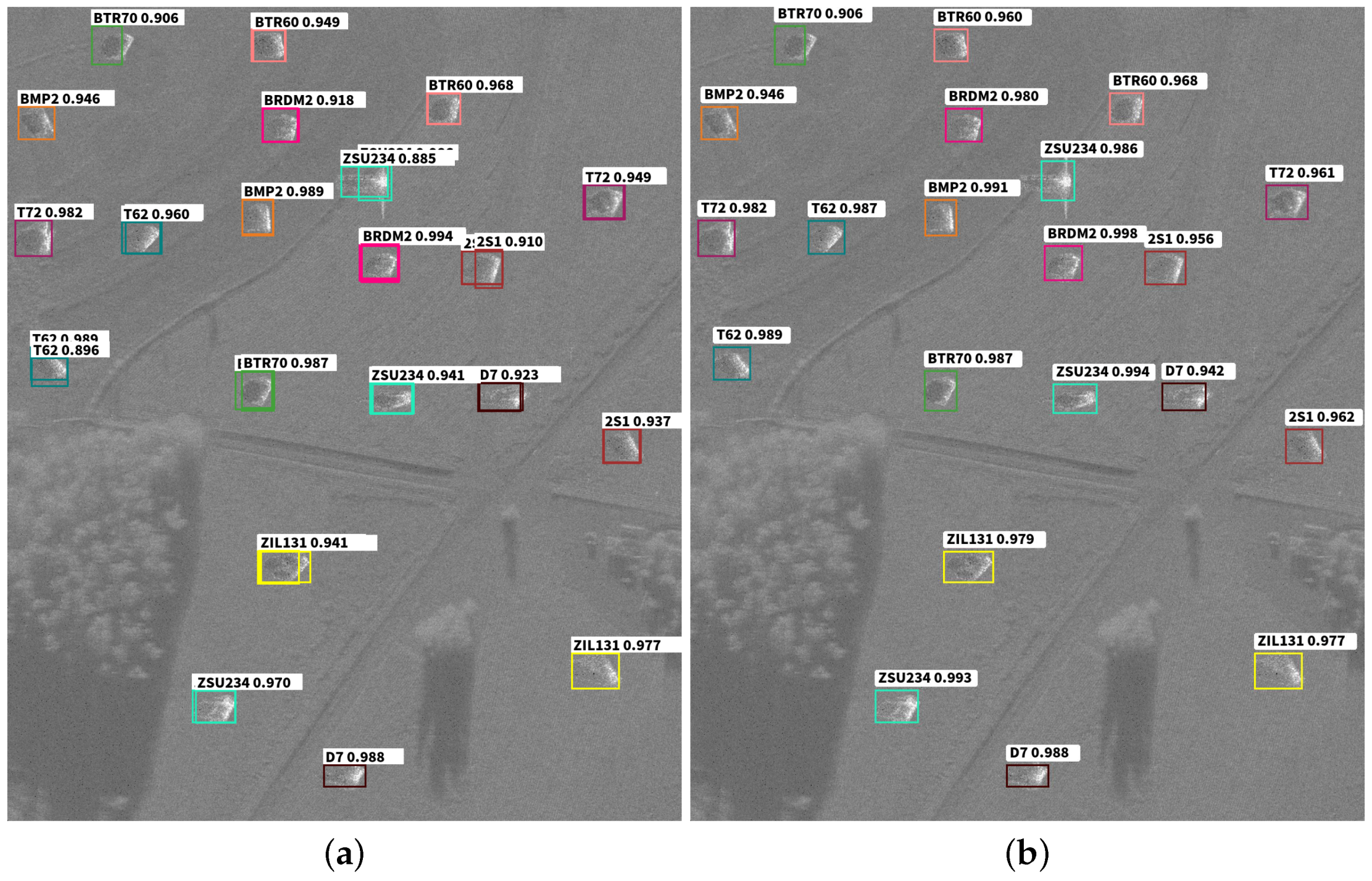D-ATR for SAR Images Based on Deep Neural Networks
Abstract
:1. Introduction
2. Structure of The D-ATR
2.1. Base Network
2.2. Additional Feature Layers
2.2.1. Convolutional Layer
2.2.2. Receptive Field
2.2.3. Detector and Classifier
2.2.4. Overall Training Process
- Step 1:
- Obtain the basic features of the input image by forward propagation;
- Step 2:
- Extract multi-scale feature maps and select candidate regions with different scales and different aspect ratios in these feature maps;
- Step 3:
- Calculate the coordinate position offset and category score of each candidate area;
- Step 4:
- Calculate the final region, according to the offsets of the candidate region and the coordinate position, and then calculate the loss function of the candidate region according to the category score and accumulate the final loss function; and
- Step 5:
- The weight of each layer is modified by the last loss function by a back-propagation algorithm.
2.3. Before and After Operation for DCNN
2.3.1. Fast Sliding
2.3.2. NMSS
- Step 1:
- Coordinate transformation, mapping the coordinates of the sub-images to the original image;
- Step 2:
- Retain the bounding box with highest category confidence for the current target;
- Step 3:
- Retain the bounding boxes which are independent in the image;
- Step 4:
- Calculate the intersection over union (IoU) between the rest of the boxes with the box from Step 2, and delete the bounding boxes which have an IoU exceeding the set threshold;
- Step 5:
- Continue to choose a box from the category with highest confidence from the unprocessed box and repeat Steps 1 and 2; and
- Step 6:
- Repeat the previous four steps, until the N bounding boxes with a highest category confidence of the targets are found.
3. Experiments
3.1. Dataset Generation
3.2. Accuracy of Detection and Recognition
3.3. Performance on Large Scene SAR Images
3.4. Comparison Experiments
4. Discussion
4.1. Analysis on Detection and Recognition Accuracy
4.2. Analysis on Performance of Large-Scene SAR Images
4.3. Analysis on Comparison Experiments
5. Conclusions
Author Contributions
Funding
Conflicts of Interest
References
- El-Darymli, K. Automatic Target Recognition in Synthetic Aperture Radar Imagery: A State-of-the-Art Review. IEEE Access 2017, 4, 6014–6058. [Google Scholar] [CrossRef]
- Wu, J.; Pu, W.; Huang, Y.; Yang, J.; Yang, H. Bistatic Forward-Looking SAR Focusing Using ω − k Based on Spectrum Modeling and Optimization. IEEE J. Sel. Top. Appl. Earth Obs. Remote Sens. 2018, 11, 4500–4512. [Google Scholar] [CrossRef]
- Bhanu, B.; Jones, T.L. Image understanding research for automatic target recognition. IEEE Aerosp. Electron. Syst. Mag. 1993, 8, 15–23. [Google Scholar] [CrossRef]
- Karine, A.; Toumi, A.; Khenchaf, A.; El Hassouni, M. Radar Target Recognition Using Salient Keypoint Descriptors and Multitask Sparse Representation. Remote Sens. 2018, 10, 843. [Google Scholar] [CrossRef]
- Zhao, Q.; Principe, J.C. Support vector machines for SAR automatic target recognition. IEEE Trans. Aerosp. Electron. Syst. 2001, 37, 643–654. [Google Scholar] [CrossRef]
- Novak, L.M.; Benitz, G.R.; Owirka, G.J.; Bessette, L.A. ATR performance using enhanced resolution SAR. In Proceedings of the Algorithms for Synthetic Aperture Radar Imagery III. International Society for Optics and Photonics, Orlando, FL, USA, 8–12 April 1996; Volume 2757, pp. 332–338. [Google Scholar]
- Bhatnagar, V.; Shaw, A.K.; Williams, R.W. Improved automatic target recognition using singular value decomposition. In Proceedings of the 1998 IEEE International Conference on Acoustics, Speech and Signal Processing, Seattle, WA, USA, 15 May 1998; Volume 5, pp. 2717–2720. [Google Scholar] [CrossRef]
- Tison, C.; Pourthie, N.; Souyris, J.C. Target recognition in SAR images with Support Vector Machines (SVM). In Proceedings of the 2007 IEEE International Geoscience and Remote Sensing Symposium, Barcelona, Spain, 23–28 July 2007; pp. 456–459. [Google Scholar] [CrossRef]
- Kaplan, L.M. Analysis of multiplicative speckle models for template-based SAR ATR. IEEE Trans. Aerosp. Electron. Syst. 2001, 37, 1424–1432. [Google Scholar] [CrossRef]
- Novak, L.M.; Owirka, G.J.; Brower, W.S.; Weaver, A.L. The automatic target-recognition system in SAIP. Linc. Lab. J. 1997, 10, 187–202. [Google Scholar]
- Robey, F.C.; Fuhrmann, D.R.; Kelly, E.J.; Nitzberg, R. A CFAR adaptive matched filter detector. IEEE Trans. Aerosp. Electron. Syst. 1992, 28, 208–216. [Google Scholar] [CrossRef]
- Clemente, C.; Pallotta, L.; Proudler, I.; De Maio, A.; Soraghan, J.J.; Farina, A. Pseudo-Zernike Based Multi-Pass Automatic Target Recognition From Multi-Channel SAR. IET Radar Sonar Navig. 2015, 9, 457–466. [Google Scholar] [CrossRef]
- Clemente, C.; Pallotta, L.; Gaglione, D.; De Maio, A.; Soraghan, J.J. Automatic target recognition of military vehicles with Krawtchouk moments. IEEE Trans. Aerosp. Electron. Syst. 2017, 53, 493–500. [Google Scholar] [CrossRef]
- Sun, Y.; Liu, Z.; Todorovic, S.; Li, J. Adaptive boosting for SAR automatic target recognition. IEEE Trans. Aerosp. Electron. Syst. 2007, 43, 112–125. [Google Scholar] [CrossRef]
- Morgan, D.A. Deep convolutional neural networks for ATR from SAR imagery. In Proceedings of the Algorithms for Synthetic Aperture Radar Imagery XXII. International Society for Optics and Photonics, Baltimore, MD, USA, 20–24 April 2015; Volume 9475, p. 94750F. [Google Scholar]
- Huang, Y.; Pei, J.; Yang, J.; Wang, B.; Liu, X. Neighborhood geometric center scaling embedding for SAR ATR. IEEE Trans. Aerosp. Electron. Syst. 2014, 50, 180–192. [Google Scholar] [CrossRef]
- Girshick, R.; Donahue, J.; Darrell, T.; Malik, J. Rich Feature Hierarchies for Accurate Object Detection and Semantic Segmentation. In Proceedings of the 2014 IEEE Conference on Computer Vision and Pattern Recognition, Columbus, OH, USA, 23–28 June 2014; pp. 580–587. [Google Scholar] [CrossRef]
- Girshick, R. Fast R-CNN. Comput. Sci. 2015, 1440–1448. [Google Scholar]
- Ren, S.; He, K.; Girshick, R.; Sun, J. Faster R-CNN: Towards real-time object detection with region proposal networks. In Proceedings of the International Conference on Neural Information Processing Systems, Montreal, QC, Canada, 7–12 December 2015; pp. 91–99. [Google Scholar]
- Redmon, J.; Divvala, S.; Girshick, R.; Farhadi, A. You only look once: Unified, real-time object detection. In Proceedings of the IEEE Conference on Computer Vision and Pattern Recognition, Las Vegas, NV, USA, 27–30 June 2016; pp. 779–788. [Google Scholar]
- Liu, W.; Anguelov, D.; Erhan, D.; Szegedy, C.; Reed, S.; Fu, C.Y.; Berg, A.C. Ssd: Single shot multibox detector. In European Conference on Computer Vision; Springer: Berlin, Germany, 2016; pp. 21–37. [Google Scholar]
- Chen, S.; Wang, H.; Xu, F.; Jin, Y.Q. Target classification using the deep convolutional networks for SAR images. IEEE Trans. Geosci. Remote Sens. 2016, 54, 4806–4817. [Google Scholar] [CrossRef]
- Kechagias-Stamatis, O.; Aouf, N. Fusing Deep Learning and Sparse Coding for SAR ATR. IEEE Trans. Aerosp. Electron. Syst. 2018. [Google Scholar] [CrossRef]
- Amrani, M.; Jiang, F.; Xu, Y.; Liu, S.; Zhang, S. SAR-Oriented Visual Saliency Model and Directed Acyclic Graph Support Vector Metric Based Target Classification. IEEE J. Sel. Top. Appl. Earth Obs. Remote Sens. 2018, 11, 3794–3810. [Google Scholar] [CrossRef]
- Wang, Z.; Du, L.; Zhang, P.; Li, L.; Wang, F.; Xu, S.; Su, H. Visual Attention-Based Target Detection and Discrimination for High-Resolution SAR Images in Complex Scenes. IEEE Trans. Geosci. Remote Sens. 2018, 56, 1855–1872. [Google Scholar] [CrossRef]
- Wang, S.; Cui, Z.; Cao, Z. Target recognition in large scene SAR images based on region proposal regression. In Proceedings of the 2017 IEEE International Geoscience and Remote Sensing Symposium (IGARSS), Fort Worth, TX, USA, 23–28 July 2017; pp. 3297–3300. [Google Scholar]
- Cui, Z.; Dang, S.; Cao, Z.; Wang, S.; Liu, N. SAR Target Recognition in Large Scene Images via Region-Based Convolutional Neural Networks. Remote Sens. 2018, 10, 776. [Google Scholar] [CrossRef]
- Krizhevsky, A.; Sutskever, I.; Hinton, G.E. ImageNet classification with deep convolutional neural networks. In Proceedings of the International Conference on Neural Information Processing Systems, Lake Tahoe, NV, USA, 3–6 December 2012; pp. 1097–1105. [Google Scholar]
- Simonyan, K.; Zisserman, A. Very Deep Convolutional Networks for Large-Scale Image Recognition. arXiv 2014, arXiv:1409.1556. [Google Scholar]
- Szegedy, C.; Liu, W.; Jia, Y.; Sermanet, P.; Reed, S.; Anguelov, D.; Erhan, D.; Vanhoucke, V.; Rabinovich, A. Going deeper with convolutions. In Proceedings of the 2015 IEEE Conference on Computer Vision and Pattern Recognition (CVPR), Boston, MA, USA, 7–12 June 2015; pp. 1–9. [Google Scholar] [CrossRef]
- He, K.; Zhang, X.; Ren, S.; Sun, J. Deep Residual Learning for Image Recognition. Comput. Vis. Pattern Recognit. 2016, arXiv:1512.03385, 770–778. [Google Scholar]
- Huang, Z.; Pan, Z.; Lei, B. Transfer Learning with Deep Convolutional Neural Network for SAR Target Classification with Limited Labeled Data. Remote Sens. 2017, 9, 907. [Google Scholar] [CrossRef]
- Kang, C.; He, C. SAR image classification based on the multi-layer network and transfer learning of mid-level representations. In Proceedings of the 2016 IEEE International Geoscience and Remote Sensing Symposium, Beijing, China, 10–15 July 2016. [Google Scholar]
- Russakovsky, O.; Deng, J.; Su, H.; Krause, J.; Satheesh, S.; Ma, S.; Huang, Z.; Karpathy, A.; Khosla, A.; Bernstein, M. ImageNet Large Scale Visual Recognition Challenge. Int. J. Comput. Vis. 2014, 115, 211–252. [Google Scholar] [CrossRef]
- Zeiler, M.D.; Fergus, R. Visualizing and Understanding Convolutional Networks; Springer: Cham, Switzerland, 2014; pp. 818–833. [Google Scholar]
- Zheng, L.; Zhao, Y.; Wang, S.; Wang, J.; Tian, Q. Good Practice in CNN Feature Transfer. arXiv 2016, arXiv:1604.00133. [Google Scholar]
- Zhang, T.; Liang, J.; Yang, Y.; Cui, G.; Kong, L.; Yang, X. Antenna Deployment Method for Multistatic Radar under the Situation of Multiple Regions for Interference. Signal Process. 2018, 143, 292–297. [Google Scholar] [CrossRef]
- Hosang, J.; Benenson, R.; Schiele, B. Learning Non-maximum Suppression. In Proceedings of the 2017 IEEE Conference on Computer Vision and Pattern Recognition (CVPR), Honolulu, HI, USA, 21–26 July 2017; pp. 6469–6477. [Google Scholar] [CrossRef]
- An, W.; Xie, C.; Yuan, X. An Improved Iterative Censoring Scheme for CFAR Ship Detection With SAR Imagery. IEEE Trans. Geosci. Remote Sens. 2014, 52, 4585–4595. [Google Scholar]
- Redmon, J.; Farhadi, A. YOLO9000: Better, Faster, Stronger. In Proceedings of the IEEE Conference on Computer Vision & Pattern Recognition (CVPR), Honolulu, HI, USA, 21–26 July 2017; pp. 7263–7271. [Google Scholar]










| CONV Layer | CONV1 | CONV2 | CONV3 | CONV4 | CONV5 |
|---|---|---|---|---|---|
| CONV stride | 1 | 2 | 2 | 1 | 1 |
| filter size | 3 × 3 | 3 × 3 | 3 × 3 | 3 × 3 | 3 × 3 |
| Feature map | 19 × 19 | 10 × 10 | 5 × 5 | 3 × 3 | 1 × 1 |
| Targets | Train | Test | ||||
|---|---|---|---|---|---|---|
| Serial No. | No. Images | Depression | Serial No. | No. Images | Depression | |
| BMP2 | 9563,9566,c21 | 698 | 17° | 9563,9566,c21 | 587 | 15° |
| BTR70 | c71 | 233 | 17° | c71 | 196 | 15° |
| T72 | 132,812,s7 | 691 | 17° | 132,812,s7 | 582 | 15° |
| BTR60 | k10yt7532 | 256 | 17° | k10yt7532 | 195 | 15° |
| 2S1 | b01 | 299 | 17° | b01 | 274 | 15° |
| BRDM2 | E71 | 299 | 17° | E71 | 298 | 15° |
| D7 | 92v13015 | 299 | 17° | 92v13015 | 274 | 15° |
| T62 | A51 | 299 | 17° | A51 | 273 | 15° |
| ZIL131 | E12 | 299 | 17° | E12 | 274 | 15° |
| ZSU234 | d08 | 299 | 17° | d08 | 274 | 15° |
| Targets | Corresponding Number |
|---|---|
| BMP2 | 1,2,3,4,5 |
| BTR70 | 6,7,8,9,10 |
| T72 | 11,12,13,14,15 |
| Class | BMP2 | BTR70 | T72 | Accuracy |
|---|---|---|---|---|
| BMP2 | 578 | 0 | 9 | 98.4% |
| BTR70 | 0 | 196 | 0 | 100% |
| T72 | 3 | 0 | 579 | 99.4% |
| Average | - | - | - | 99.3% |
| Class | BMP2 | BTR70 | T72 | BTR60 | 2S1 | BRDM2 | D7 | T62 | ZIL131 | ZSU234 | Accuracy |
|---|---|---|---|---|---|---|---|---|---|---|---|
| BMP2 | 582 | 2 | 3 | 0 | 0 | 0 | 0 | 0 | 0 | 0 | 99% |
| BTR70 | 0 | 196 | 30 | 0 | 0 | 0 | 0 | 0 | 0 | 0 | 100% |
| T72 | 1 | 0 | 581 | 0 | 0 | 0 | 0 | 0 | 0 | 0 | 99.8% |
| BTR60 | 0 | 0 | 0 | 185 | 2 | 2 | 1 | 1 | 1 | 3 | 94.8% |
| 2S1 | 0 | 0 | 0 | 1 | 208 | 0 | 0 | 46 | 19 | 0 | 75.9% |
| BRDM2 | 0 | 0 | 0 | 0 | 0 | 270 | 0 | 0 | 4 | 0 | 98.5% |
| D7 | 0 | 0 | 0 | 0 | 0 | 0 | 274 | 0 | 0 | 0 | 100% |
| T62 | 0 | 0 | 0 | 0 | 0 | 0 | 0 | 266 | 0 | 7 | 97.4% |
| ZIL131 | 0 | 0 | 0 | 0 | 0 | 0 | 1 | 0 | 273 | 0 | 99.6% |
| ZSU234 | 0 | 0 | 0 | 0 | 0 | 0 | 0 | 0 | 0 | 273 | 100% |
| Average | - | - | - | - | - | - | - | - | - | - | 96.5% |
| SAR Image | Method | No. Target | No. Det | Det Rate | No. Rec | Rec Rate | Time (s) |
|---|---|---|---|---|---|---|---|
| Figure 10a | CFAR+SVM | 15 | 14 | 93% | 13 | 92.86% | 20.9 |
| Region-based CNN | 15 | 15 | 100% | 15 | 100 % | 23.1 | |
| YOLO-2 | 15 | 11 | 73.33% | 11 | 100% | 1.5 | |
| Proposed method | 15 | 15 | 100% | 15 | 100% | 5.8 | |
| Figure 10b | CFAR+SVM | 15 | 9 | 60% | 8 | 88.9% | 21.3 |
| Region-based CNN | 15 | 15 | 100% | 15 | 100% | 23.3 | |
| YOLO-2 | 15 | 10 | 66.67% | 10 | 100% | 1.6 | |
| Proposed method | 15 | 15 | 100% | 15 | 100% | 6.8 |
© 2019 by the authors. Licensee MDPI, Basel, Switzerland. This article is an open access article distributed under the terms and conditions of the Creative Commons Attribution (CC BY) license (http://creativecommons.org/licenses/by/4.0/).
Share and Cite
Cui, Z.; Tang, C.; Cao, Z.; Liu, N. D-ATR for SAR Images Based on Deep Neural Networks. Remote Sens. 2019, 11, 906. https://doi.org/10.3390/rs11080906
Cui Z, Tang C, Cao Z, Liu N. D-ATR for SAR Images Based on Deep Neural Networks. Remote Sensing. 2019; 11(8):906. https://doi.org/10.3390/rs11080906
Chicago/Turabian StyleCui, Zongyong, Cui Tang, Zongjie Cao, and Nengyuan Liu. 2019. "D-ATR for SAR Images Based on Deep Neural Networks" Remote Sensing 11, no. 8: 906. https://doi.org/10.3390/rs11080906
APA StyleCui, Z., Tang, C., Cao, Z., & Liu, N. (2019). D-ATR for SAR Images Based on Deep Neural Networks. Remote Sensing, 11(8), 906. https://doi.org/10.3390/rs11080906






